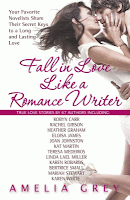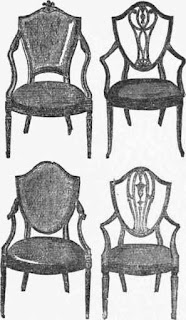 I hope you’re all having a lovely Tuesday! I am about to jump back into writing an “Undone” short story I’ve been buried in all weekend (I sorta forgot it was due soon, but don’t tell!), and my head is full of Renaissance-era Scotland, but right now I get to take a break and hang out at the Riskies.
I hope you’re all having a lovely Tuesday! I am about to jump back into writing an “Undone” short story I’ve been buried in all weekend (I sorta forgot it was due soon, but don’t tell!), and my head is full of Renaissance-era Scotland, but right now I get to take a break and hang out at the Riskies.
There’s new book out next month that looks like a lot of fun, Fall in Love Like a Romance Author–and I have an essay in it about dating as a single writer! (If I had to find one word to describe dating–interesting. I may have to post about dating tips for romance authors here soon…). Since I’m incurably nosy about other people’s life stories, I can’t wait to read the other essays. And it’s just in time for Valentine’s Day too!
And since the Golden Globes were this weekend, of course I have opinions! I posted about the red carpet fashion on my own blog–it was one of the most interesting rc’s in a while, and bodes well for the Oscars!
 As part of my New Years resolutions, I’ve been going to more dance classes as well as teaching on Saturday, and it’s been very–challenging. Especially since, after several years off, I’ve decided to get the pointe shoes out again since I’ve been strengthening my feet and legs. My toes are not thanking me. But here is a brief look at the history of the pointe shoe:
As part of my New Years resolutions, I’ve been going to more dance classes as well as teaching on Saturday, and it’s been very–challenging. Especially since, after several years off, I’ve decided to get the pointe shoes out again since I’ve been strengthening my feet and legs. My toes are not thanking me. But here is a brief look at the history of the pointe shoe:
In the Renaissance era, court masques were all the rage, where courtiers could put on elaborate costumes and act out allegorical stories amid fantastical scenery, and dancing was a huge part of that. When Catherine de Medici married into the French royal family, she brought this ballet de cour (“court ballet”) to Paris and, being French, they took to the spectacle right away. In the 1600s this art form reached a pinnacle under Louis XIV, who danced in them himself as a young man. He founded the Academie Royale de Danse (later the Paris Opera Ballet). At that time, the men did most of the elaborate dancing, while women, in heavy gowns and heeled shoes, were merely set dressing.
But by the 1730s, dancing of this sort was more theatrical than court, and a style known as “danse haute”, involving leaping and twirling, became the rage. Marie Camargo started a trend by taking the heels from her shoes and heavily darning the toes. Skirts got shorter and turns got faster. By 1830, Marie Taglioni took the dance world by storm. In that year, she danced the very Romantic ballet La Sylphide on the tops of her toes, and what had just been a sort of trick before became the norm of artistic expression. (In Russia, her fans even sometimes cooked her used shoes and ate them with sauce–ugh).
The 19th century was when the classical ballets were know so well today (Giselle, Swan Lake, La Bayadere) came into being, and so many of them feature a central heroine who is an ethereal being, a spirit not bound to the earth, and pointe shoes allowed the ballerina to create this illusion by seeming to hover and skim over the stage as if weightless, while the earthbound hero is enraptured. (But it usually ends badly, alas! Though I love the endings of Giselle and Swan Lake, where love can endure even death).
Taglioni’s shoes were soft satin slippers that fit her feet like a second skin, with a leather sole and heavy darning on the sides and underside. I can’t imagine going en pointe on such a shoe. By the end of the 19th century, the new Russian ballets (choreographed by Marius Petipa in the French tradition) demanded more technique, and the Italian school pushed athleticism over all. The Italians also had 2 secret weapons–the technique of spotting for turns and a better shoe. They also had shorter skirts. (When La Zucchi danced in St. Petersburg in a short skirt against the Imperial Ballet’s strict regulations, it caused a scandal!). The Russians adapted all of this, and even strengthened the shoes. Even today, Russian shoes are usually stiffer, better for the Russian technique of pouncing onto pointe rather than rolling through. (The Danish school, on the other hand, demanded a technique that required softer shoes for more bouncy jumps and elaborate footwork but fewer sustained balances and pirouettes en pointe).
 The shoes themselves haven’t developed a whole lot from the 19th century, though they are harder and boxier in the toe. They’re still made from leather, paper, burlap, glue and nails with a final layer of satin. They’re held together by 3 soles, or shanks, the outside and middle ones made of leather and the inside of cardboard. Then, with the edges of the satin and canvas between, they’re glues and nailed together. In order to wear them, they have to be broken in (there’s a brief glimpse of this brutal process in the movie Black Swan), and a professional dancer will go through several pairs a performance.
The shoes themselves haven’t developed a whole lot from the 19th century, though they are harder and boxier in the toe. They’re still made from leather, paper, burlap, glue and nails with a final layer of satin. They’re held together by 3 soles, or shanks, the outside and middle ones made of leather and the inside of cardboard. Then, with the edges of the satin and canvas between, they’re glues and nailed together. In order to wear them, they have to be broken in (there’s a brief glimpse of this brutal process in the movie Black Swan), and a professional dancer will go through several pairs a performance.
If you’d like to know more about any aspect of ballet, I highly recommend Jennifer Homan’s new history of the art, Apollo’s Angels. It’s a fascinating book.
So there you have it, a brief glimpse of the history of the ballet shoe! I feel like I need to go off and practice some plies now. What is your favorite ballet? And how are your New Years resolutions holding up now that it’s almost February? And what was your favorite gown at the Golden Globes???









